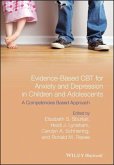Bruno A. Cayoun
Mindfulness-Integrated CBT
Bruno A. Cayoun
Mindfulness-Integrated CBT
- Broschiertes Buch
- Merkliste
- Auf die Merkliste
- Bewerten Bewerten
- Teilen
- Produkt teilen
- Produkterinnerung
- Produkterinnerung
Mindfulness-integrated CBT: Principles and Practice represents the first set of general principles and practical guidelines for the integration of mindfulness meditation with well-documented and newly developed CBT techniques to address a broad range of psychological dysfunctions. The first book to provide a strong rationale and general guidelines for the implementation of mindfulness meditation integrated with CBT for a wide range of psychological difficulties Incorporates ancient Buddhist concepts of how the mind works, while remaining firmly grounded in well-documented cognitive and…mehr
Andere Kunden interessierten sich auch für
![Mindfulness-Integrated CBT for Well-Being and Personal Growth Mindfulness-Integrated CBT for Well-Being and Personal Growth]() Bruno A. CayounMindfulness-Integrated CBT for Well-Being and Personal Growth23,99 €
Bruno A. CayounMindfulness-Integrated CBT for Well-Being and Personal Growth23,99 €![CBT and Christianity CBT and Christianity]() Michael L. FreeCBT and Christianity89,99 €
Michael L. FreeCBT and Christianity89,99 €![CBT and Christianity CBT and Christianity]() Michael L. FreeCBT and Christianity46,99 €
Michael L. FreeCBT and Christianity46,99 €![CBT Appearance CBT Appearance]() Alex ClarkeCBT Appearance53,99 €
Alex ClarkeCBT Appearance53,99 €![Evidence-Based CBT for Anxiety and Depression in Children and Adolescents Evidence-Based CBT for Anxiety and Depression in Children and Adolescents]() Elizabeth S. SburlatiEvidence-Based CBT for Anxiety and Depression in Children and Adolescents104,99 €
Elizabeth S. SburlatiEvidence-Based CBT for Anxiety and Depression in Children and Adolescents104,99 €![CBT for Schizophrenia CBT for Schizophrenia]() CBT for Schizophrenia63,99 €
CBT for Schizophrenia63,99 €![Evidence-Based CBT for Anxiety and Depression in Children and Adolescents Evidence-Based CBT for Anxiety and Depression in Children and Adolescents]() Elizabeth S. SburlatiEvidence-Based CBT for Anxiety and Depression in Children and Adolescents64,99 €
Elizabeth S. SburlatiEvidence-Based CBT for Anxiety and Depression in Children and Adolescents64,99 €-
-
-
Mindfulness-integrated CBT: Principles and Practice represents the first set of general principles and practical guidelines for the integration of mindfulness meditation with well-documented and newly developed CBT techniques to address a broad range of psychological dysfunctions.
The first book to provide a strong rationale and general guidelines for the implementation of mindfulness meditation integrated with CBT for a wide range of psychological difficulties
Incorporates ancient Buddhist concepts of how the mind works, while remaining firmly grounded in well-documented cognitive and behavioural principles
Provides new insights into established understanding of conditioning principles
Includes a comprehensive list of frequently asked questions, week-by-week instructions for professionals to facilitate application of the therapy, along with case examples and the inspiring stories of former clients
Hinweis: Dieser Artikel kann nur an eine deutsche Lieferadresse ausgeliefert werden.
The first book to provide a strong rationale and general guidelines for the implementation of mindfulness meditation integrated with CBT for a wide range of psychological difficulties
Incorporates ancient Buddhist concepts of how the mind works, while remaining firmly grounded in well-documented cognitive and behavioural principles
Provides new insights into established understanding of conditioning principles
Includes a comprehensive list of frequently asked questions, week-by-week instructions for professionals to facilitate application of the therapy, along with case examples and the inspiring stories of former clients
Hinweis: Dieser Artikel kann nur an eine deutsche Lieferadresse ausgeliefert werden.
Produktdetails
- Produktdetails
- Verlag: Wiley & Sons
- 1. Auflage
- Seitenzahl: 320
- Erscheinungstermin: 25. April 2011
- Englisch
- Abmessung: 244mm x 170mm x 17mm
- Gewicht: 548g
- ISBN-13: 9780470974957
- ISBN-10: 0470974958
- Artikelnr.: 32930387
- Herstellerkennzeichnung
- Libri GmbH
- Europaallee 1
- 36244 Bad Hersfeld
- gpsr@libri.de
- Verlag: Wiley & Sons
- 1. Auflage
- Seitenzahl: 320
- Erscheinungstermin: 25. April 2011
- Englisch
- Abmessung: 244mm x 170mm x 17mm
- Gewicht: 548g
- ISBN-13: 9780470974957
- ISBN-10: 0470974958
- Artikelnr.: 32930387
- Herstellerkennzeichnung
- Libri GmbH
- Europaallee 1
- 36244 Bad Hersfeld
- gpsr@libri.de
Bruno Cayoun DPsych is Director of the MiCBT Institute and Research Associate at the School of Psychology, University of Tasmania, and a Clinical Psychologist in private practice in Hobart, Australia. He is the principal developer of Mindfulness-integrated Cognitive Behaviour Therapy and has been teaching this approach as a crisis intervention and relapse prevention method to mental health professionals internationally for the past eight years.
About the Author.
Acknowledgments.
Preface.
Abbreviations.
Introduction.
Three Bases of Learning.
About this Book.
Part I Theoretical Foundation.
1 Operationalization of Mindfulness.
Defi nition of MiCBT.
Case Illustration with Generalized Anxiety Disorder.
Western Understanding of Eastern Conceptualization.
Changes in Western Clinical Psychology.
Summary of Main Points.
2 The Co-emergence Model of Reinforcement: A Rationale for Mindfulness
Integration.
Integrating Essential Components of Behavior Change.
Role and Phenomenology of the Four Functional Components.
Widening the Scope of Learning Theory.
A Dynamic Systems Explanation of Intrusive Thoughts.
Maintaining Mental Illness.
Recreating Balance in the System.
Summary of Main Points.
Part II Internalizing Skills.
3 Suitability and Rationale for MiCBT: Practical Guidelines for Therapists.
A Transdiagnostic Assessment.
Contraindications.
Assessing Motivation to Change: A Proposed Script.
Developing and Delivering an Appropriate Rationale.
An Experiential Rationale for Mindfulness with Breathing.
Modeling Acceptance and Equanimity in the 1st Interview.
Summary of Main Points.
4 Stage 1 of MiCBT - Part I: How to Generalize Metacognitive and
Interoceptive Exposure.
Set Up.
Relaxation as a Preparatory Measure.
Practice Overview: Description and Operationalization.
Summary of Main Points.
5 Clinical Relevance.
Confounding Factors.
Relaxation and Equanimity.
Summary of Main Points.
6 Stage 1 of MiCBT - Part II: Explaining Difficulties and Facilitating
Shifts.
Lost in Thoughts.
Dealing with Pain.
Other Typical Diffi culties.
Promoting Adherence.
Completion of Stage 1.
Summary of Main Points.
Part III Externalizing Skills.
7 Stage 2 of MiCBT: Mindful Exposure and Cognitive Reappraisal.
Aim of Stage 2.
Basic Notion of Graded Exposure in Behavior Therapy.
Exposure in Imagination.
Overcoming Imagery Limitations.
"Bi-polar Exposure."
Basic Notion of Cognitive Restructuring in Cognitive Therapy.
Some Limitations.
The Concept of Irrationality.
Cognitive Reappraisal as a Consequence of Mindfulness.
Re-evaluating the Self-Concept.
Summary of Main Points.
8 Stage 3 of MiCBT: Interpersonal Mindfulness.
Social Identity Theory.
Stage 3 and the Theory of Social Identity.
Using Stages 1 and 2 to Understand Others.
Summary of Main Points.
9 Stage 4 of MiCBT: Relapse Prevention with Grounded Empathy.
Empathy as Part of the MiCBT Model.
Consequences of Mindfulness.
Empathy as a Function of "Egolessness."
Self-Esteem.
Two Bases for Self-Acceptance.
Training in Stage 4.
Reappraising Relapse.
Summary of Main Points.
Part IV The Benefits.
10 MiCBT with DSM-V Axis 1 and Axis 2 Disorders.
Developmental versus Situational Causes of Psychopathology.
Early Cue Detection versus Experiential Avoidance.
Case Example 1: Social Phobia.
Case Example 2: PTSD.
Case Example 3: PTSD and Dysthymic Disorder.
Case Example 4: PTSD and Major Depressive Episode.
Case Example 5: PTSD and Gambling Addiction.
Case Example 6: Chronic Pain.
Case Example 7: Chronic Pain, Chronic Depression, OCD and Panic Disorder
with Agoraphobia.
Case Example 8: General Anxiety Disorder, Connective Tissue Disorder and
Osteoarthritis.
Case Example 9: Chronic Depression, General Anxiety, Binge Eating and
Diabetes.
Case Example 10: Borderline Personality Disorder.
The Issue of Personality.
Summary of Main Points.
11 Evaluation of Mindfulness Training.
Measuring Effi cacy of Mindfulness-based Treatments.
Data Collection: A Non Diagnosis-Specifi c Analysis of MiCBT.
Effects of MiCBT on Health Behavior of People with Type 2 Diabetes.
Mindfulness and Western Therapies.
Summary of Main Points.
Part V Teaching and Training.
12 Weekly Implementation Protocol.
Expected Skills Acquired with the Program.
Contact Hours for the 8- to 12-Week MiCBT Program.
Structure of Facilitator Handouts.
Summary of the 4-Stage Model.
Concluding Comment.
Follow-up Sessions.
Outline for the MiCBT Follow-up Groups.
Summary of Main Points.
13 Professional Training.
The Importance of Therapist Variables.
Effects of Mindfulness on Therapy Outcomes.
The Importance of Professional Training.
Case Example 1: Needle Phobia.
Case Example 2: Pain, Gambling Addiction and Anxiety.
Case Example 3: Pain.
Case Example 4: Distressing Situation.
Case Example 5: ADHD.
Recommendations for Clinicians.
Summary of Main Points.
14 Frequently Asked Questions.
Common Questions about Mindfulness Meditation.
Compatibility with Pharmacotherapy.
Unexplained Experiences with the Practice.
Adherence to Therapy.
Trauma.
Passion.
Pain.
MiCBT for Children.
Conducting Groups.
Contraindications.
Summary of Main Points.
References.
Glossary.
List of Appendices.
Appendix A - Scripts.
Appendix B - Assessment Tools.
Appendix C - Client Forms.
Index.
Acknowledgments.
Preface.
Abbreviations.
Introduction.
Three Bases of Learning.
About this Book.
Part I Theoretical Foundation.
1 Operationalization of Mindfulness.
Defi nition of MiCBT.
Case Illustration with Generalized Anxiety Disorder.
Western Understanding of Eastern Conceptualization.
Changes in Western Clinical Psychology.
Summary of Main Points.
2 The Co-emergence Model of Reinforcement: A Rationale for Mindfulness
Integration.
Integrating Essential Components of Behavior Change.
Role and Phenomenology of the Four Functional Components.
Widening the Scope of Learning Theory.
A Dynamic Systems Explanation of Intrusive Thoughts.
Maintaining Mental Illness.
Recreating Balance in the System.
Summary of Main Points.
Part II Internalizing Skills.
3 Suitability and Rationale for MiCBT: Practical Guidelines for Therapists.
A Transdiagnostic Assessment.
Contraindications.
Assessing Motivation to Change: A Proposed Script.
Developing and Delivering an Appropriate Rationale.
An Experiential Rationale for Mindfulness with Breathing.
Modeling Acceptance and Equanimity in the 1st Interview.
Summary of Main Points.
4 Stage 1 of MiCBT - Part I: How to Generalize Metacognitive and
Interoceptive Exposure.
Set Up.
Relaxation as a Preparatory Measure.
Practice Overview: Description and Operationalization.
Summary of Main Points.
5 Clinical Relevance.
Confounding Factors.
Relaxation and Equanimity.
Summary of Main Points.
6 Stage 1 of MiCBT - Part II: Explaining Difficulties and Facilitating
Shifts.
Lost in Thoughts.
Dealing with Pain.
Other Typical Diffi culties.
Promoting Adherence.
Completion of Stage 1.
Summary of Main Points.
Part III Externalizing Skills.
7 Stage 2 of MiCBT: Mindful Exposure and Cognitive Reappraisal.
Aim of Stage 2.
Basic Notion of Graded Exposure in Behavior Therapy.
Exposure in Imagination.
Overcoming Imagery Limitations.
"Bi-polar Exposure."
Basic Notion of Cognitive Restructuring in Cognitive Therapy.
Some Limitations.
The Concept of Irrationality.
Cognitive Reappraisal as a Consequence of Mindfulness.
Re-evaluating the Self-Concept.
Summary of Main Points.
8 Stage 3 of MiCBT: Interpersonal Mindfulness.
Social Identity Theory.
Stage 3 and the Theory of Social Identity.
Using Stages 1 and 2 to Understand Others.
Summary of Main Points.
9 Stage 4 of MiCBT: Relapse Prevention with Grounded Empathy.
Empathy as Part of the MiCBT Model.
Consequences of Mindfulness.
Empathy as a Function of "Egolessness."
Self-Esteem.
Two Bases for Self-Acceptance.
Training in Stage 4.
Reappraising Relapse.
Summary of Main Points.
Part IV The Benefits.
10 MiCBT with DSM-V Axis 1 and Axis 2 Disorders.
Developmental versus Situational Causes of Psychopathology.
Early Cue Detection versus Experiential Avoidance.
Case Example 1: Social Phobia.
Case Example 2: PTSD.
Case Example 3: PTSD and Dysthymic Disorder.
Case Example 4: PTSD and Major Depressive Episode.
Case Example 5: PTSD and Gambling Addiction.
Case Example 6: Chronic Pain.
Case Example 7: Chronic Pain, Chronic Depression, OCD and Panic Disorder
with Agoraphobia.
Case Example 8: General Anxiety Disorder, Connective Tissue Disorder and
Osteoarthritis.
Case Example 9: Chronic Depression, General Anxiety, Binge Eating and
Diabetes.
Case Example 10: Borderline Personality Disorder.
The Issue of Personality.
Summary of Main Points.
11 Evaluation of Mindfulness Training.
Measuring Effi cacy of Mindfulness-based Treatments.
Data Collection: A Non Diagnosis-Specifi c Analysis of MiCBT.
Effects of MiCBT on Health Behavior of People with Type 2 Diabetes.
Mindfulness and Western Therapies.
Summary of Main Points.
Part V Teaching and Training.
12 Weekly Implementation Protocol.
Expected Skills Acquired with the Program.
Contact Hours for the 8- to 12-Week MiCBT Program.
Structure of Facilitator Handouts.
Summary of the 4-Stage Model.
Concluding Comment.
Follow-up Sessions.
Outline for the MiCBT Follow-up Groups.
Summary of Main Points.
13 Professional Training.
The Importance of Therapist Variables.
Effects of Mindfulness on Therapy Outcomes.
The Importance of Professional Training.
Case Example 1: Needle Phobia.
Case Example 2: Pain, Gambling Addiction and Anxiety.
Case Example 3: Pain.
Case Example 4: Distressing Situation.
Case Example 5: ADHD.
Recommendations for Clinicians.
Summary of Main Points.
14 Frequently Asked Questions.
Common Questions about Mindfulness Meditation.
Compatibility with Pharmacotherapy.
Unexplained Experiences with the Practice.
Adherence to Therapy.
Trauma.
Passion.
Pain.
MiCBT for Children.
Conducting Groups.
Contraindications.
Summary of Main Points.
References.
Glossary.
List of Appendices.
Appendix A - Scripts.
Appendix B - Assessment Tools.
Appendix C - Client Forms.
Index.
About the Author.
Acknowledgments.
Preface.
Abbreviations.
Introduction.
Three Bases of Learning.
About this Book.
Part I Theoretical Foundation.
1 Operationalization of Mindfulness.
Defi nition of MiCBT.
Case Illustration with Generalized Anxiety Disorder.
Western Understanding of Eastern Conceptualization.
Changes in Western Clinical Psychology.
Summary of Main Points.
2 The Co-emergence Model of Reinforcement: A Rationale for Mindfulness
Integration.
Integrating Essential Components of Behavior Change.
Role and Phenomenology of the Four Functional Components.
Widening the Scope of Learning Theory.
A Dynamic Systems Explanation of Intrusive Thoughts.
Maintaining Mental Illness.
Recreating Balance in the System.
Summary of Main Points.
Part II Internalizing Skills.
3 Suitability and Rationale for MiCBT: Practical Guidelines for Therapists.
A Transdiagnostic Assessment.
Contraindications.
Assessing Motivation to Change: A Proposed Script.
Developing and Delivering an Appropriate Rationale.
An Experiential Rationale for Mindfulness with Breathing.
Modeling Acceptance and Equanimity in the 1st Interview.
Summary of Main Points.
4 Stage 1 of MiCBT - Part I: How to Generalize Metacognitive and
Interoceptive Exposure.
Set Up.
Relaxation as a Preparatory Measure.
Practice Overview: Description and Operationalization.
Summary of Main Points.
5 Clinical Relevance.
Confounding Factors.
Relaxation and Equanimity.
Summary of Main Points.
6 Stage 1 of MiCBT - Part II: Explaining Difficulties and Facilitating
Shifts.
Lost in Thoughts.
Dealing with Pain.
Other Typical Diffi culties.
Promoting Adherence.
Completion of Stage 1.
Summary of Main Points.
Part III Externalizing Skills.
7 Stage 2 of MiCBT: Mindful Exposure and Cognitive Reappraisal.
Aim of Stage 2.
Basic Notion of Graded Exposure in Behavior Therapy.
Exposure in Imagination.
Overcoming Imagery Limitations.
"Bi-polar Exposure."
Basic Notion of Cognitive Restructuring in Cognitive Therapy.
Some Limitations.
The Concept of Irrationality.
Cognitive Reappraisal as a Consequence of Mindfulness.
Re-evaluating the Self-Concept.
Summary of Main Points.
8 Stage 3 of MiCBT: Interpersonal Mindfulness.
Social Identity Theory.
Stage 3 and the Theory of Social Identity.
Using Stages 1 and 2 to Understand Others.
Summary of Main Points.
9 Stage 4 of MiCBT: Relapse Prevention with Grounded Empathy.
Empathy as Part of the MiCBT Model.
Consequences of Mindfulness.
Empathy as a Function of "Egolessness."
Self-Esteem.
Two Bases for Self-Acceptance.
Training in Stage 4.
Reappraising Relapse.
Summary of Main Points.
Part IV The Benefits.
10 MiCBT with DSM-V Axis 1 and Axis 2 Disorders.
Developmental versus Situational Causes of Psychopathology.
Early Cue Detection versus Experiential Avoidance.
Case Example 1: Social Phobia.
Case Example 2: PTSD.
Case Example 3: PTSD and Dysthymic Disorder.
Case Example 4: PTSD and Major Depressive Episode.
Case Example 5: PTSD and Gambling Addiction.
Case Example 6: Chronic Pain.
Case Example 7: Chronic Pain, Chronic Depression, OCD and Panic Disorder
with Agoraphobia.
Case Example 8: General Anxiety Disorder, Connective Tissue Disorder and
Osteoarthritis.
Case Example 9: Chronic Depression, General Anxiety, Binge Eating and
Diabetes.
Case Example 10: Borderline Personality Disorder.
The Issue of Personality.
Summary of Main Points.
11 Evaluation of Mindfulness Training.
Measuring Effi cacy of Mindfulness-based Treatments.
Data Collection: A Non Diagnosis-Specifi c Analysis of MiCBT.
Effects of MiCBT on Health Behavior of People with Type 2 Diabetes.
Mindfulness and Western Therapies.
Summary of Main Points.
Part V Teaching and Training.
12 Weekly Implementation Protocol.
Expected Skills Acquired with the Program.
Contact Hours for the 8- to 12-Week MiCBT Program.
Structure of Facilitator Handouts.
Summary of the 4-Stage Model.
Concluding Comment.
Follow-up Sessions.
Outline for the MiCBT Follow-up Groups.
Summary of Main Points.
13 Professional Training.
The Importance of Therapist Variables.
Effects of Mindfulness on Therapy Outcomes.
The Importance of Professional Training.
Case Example 1: Needle Phobia.
Case Example 2: Pain, Gambling Addiction and Anxiety.
Case Example 3: Pain.
Case Example 4: Distressing Situation.
Case Example 5: ADHD.
Recommendations for Clinicians.
Summary of Main Points.
14 Frequently Asked Questions.
Common Questions about Mindfulness Meditation.
Compatibility with Pharmacotherapy.
Unexplained Experiences with the Practice.
Adherence to Therapy.
Trauma.
Passion.
Pain.
MiCBT for Children.
Conducting Groups.
Contraindications.
Summary of Main Points.
References.
Glossary.
List of Appendices.
Appendix A - Scripts.
Appendix B - Assessment Tools.
Appendix C - Client Forms.
Index.
Acknowledgments.
Preface.
Abbreviations.
Introduction.
Three Bases of Learning.
About this Book.
Part I Theoretical Foundation.
1 Operationalization of Mindfulness.
Defi nition of MiCBT.
Case Illustration with Generalized Anxiety Disorder.
Western Understanding of Eastern Conceptualization.
Changes in Western Clinical Psychology.
Summary of Main Points.
2 The Co-emergence Model of Reinforcement: A Rationale for Mindfulness
Integration.
Integrating Essential Components of Behavior Change.
Role and Phenomenology of the Four Functional Components.
Widening the Scope of Learning Theory.
A Dynamic Systems Explanation of Intrusive Thoughts.
Maintaining Mental Illness.
Recreating Balance in the System.
Summary of Main Points.
Part II Internalizing Skills.
3 Suitability and Rationale for MiCBT: Practical Guidelines for Therapists.
A Transdiagnostic Assessment.
Contraindications.
Assessing Motivation to Change: A Proposed Script.
Developing and Delivering an Appropriate Rationale.
An Experiential Rationale for Mindfulness with Breathing.
Modeling Acceptance and Equanimity in the 1st Interview.
Summary of Main Points.
4 Stage 1 of MiCBT - Part I: How to Generalize Metacognitive and
Interoceptive Exposure.
Set Up.
Relaxation as a Preparatory Measure.
Practice Overview: Description and Operationalization.
Summary of Main Points.
5 Clinical Relevance.
Confounding Factors.
Relaxation and Equanimity.
Summary of Main Points.
6 Stage 1 of MiCBT - Part II: Explaining Difficulties and Facilitating
Shifts.
Lost in Thoughts.
Dealing with Pain.
Other Typical Diffi culties.
Promoting Adherence.
Completion of Stage 1.
Summary of Main Points.
Part III Externalizing Skills.
7 Stage 2 of MiCBT: Mindful Exposure and Cognitive Reappraisal.
Aim of Stage 2.
Basic Notion of Graded Exposure in Behavior Therapy.
Exposure in Imagination.
Overcoming Imagery Limitations.
"Bi-polar Exposure."
Basic Notion of Cognitive Restructuring in Cognitive Therapy.
Some Limitations.
The Concept of Irrationality.
Cognitive Reappraisal as a Consequence of Mindfulness.
Re-evaluating the Self-Concept.
Summary of Main Points.
8 Stage 3 of MiCBT: Interpersonal Mindfulness.
Social Identity Theory.
Stage 3 and the Theory of Social Identity.
Using Stages 1 and 2 to Understand Others.
Summary of Main Points.
9 Stage 4 of MiCBT: Relapse Prevention with Grounded Empathy.
Empathy as Part of the MiCBT Model.
Consequences of Mindfulness.
Empathy as a Function of "Egolessness."
Self-Esteem.
Two Bases for Self-Acceptance.
Training in Stage 4.
Reappraising Relapse.
Summary of Main Points.
Part IV The Benefits.
10 MiCBT with DSM-V Axis 1 and Axis 2 Disorders.
Developmental versus Situational Causes of Psychopathology.
Early Cue Detection versus Experiential Avoidance.
Case Example 1: Social Phobia.
Case Example 2: PTSD.
Case Example 3: PTSD and Dysthymic Disorder.
Case Example 4: PTSD and Major Depressive Episode.
Case Example 5: PTSD and Gambling Addiction.
Case Example 6: Chronic Pain.
Case Example 7: Chronic Pain, Chronic Depression, OCD and Panic Disorder
with Agoraphobia.
Case Example 8: General Anxiety Disorder, Connective Tissue Disorder and
Osteoarthritis.
Case Example 9: Chronic Depression, General Anxiety, Binge Eating and
Diabetes.
Case Example 10: Borderline Personality Disorder.
The Issue of Personality.
Summary of Main Points.
11 Evaluation of Mindfulness Training.
Measuring Effi cacy of Mindfulness-based Treatments.
Data Collection: A Non Diagnosis-Specifi c Analysis of MiCBT.
Effects of MiCBT on Health Behavior of People with Type 2 Diabetes.
Mindfulness and Western Therapies.
Summary of Main Points.
Part V Teaching and Training.
12 Weekly Implementation Protocol.
Expected Skills Acquired with the Program.
Contact Hours for the 8- to 12-Week MiCBT Program.
Structure of Facilitator Handouts.
Summary of the 4-Stage Model.
Concluding Comment.
Follow-up Sessions.
Outline for the MiCBT Follow-up Groups.
Summary of Main Points.
13 Professional Training.
The Importance of Therapist Variables.
Effects of Mindfulness on Therapy Outcomes.
The Importance of Professional Training.
Case Example 1: Needle Phobia.
Case Example 2: Pain, Gambling Addiction and Anxiety.
Case Example 3: Pain.
Case Example 4: Distressing Situation.
Case Example 5: ADHD.
Recommendations for Clinicians.
Summary of Main Points.
14 Frequently Asked Questions.
Common Questions about Mindfulness Meditation.
Compatibility with Pharmacotherapy.
Unexplained Experiences with the Practice.
Adherence to Therapy.
Trauma.
Passion.
Pain.
MiCBT for Children.
Conducting Groups.
Contraindications.
Summary of Main Points.
References.
Glossary.
List of Appendices.
Appendix A - Scripts.
Appendix B - Assessment Tools.
Appendix C - Client Forms.
Index.









